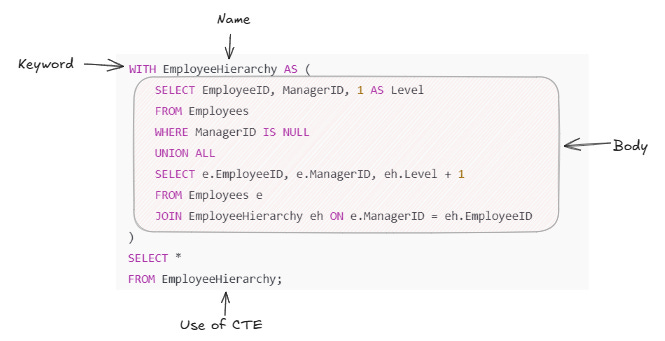Everything You Need to Know About CTEs in SQL Server and Beyond
CTEs: The Key to Efficient and Readable Queries in SQL Server
What Are CTEs and Why Are They Important?
Common Table Expressions (CTEs) are a powerful SQL feature that allows you to simplify complex queries, make them more readable, and structure them efficiently. They’re especially useful for solving hierarchical or recursive problems while keeping your SQL code clean and modular.
Although CTEs don't inherently guarantee performance improvements, they are invaluable for writing better-structured queries in systems like SQL Server, PostgreSQL, Oracle, and others. In this newsletter, we’ll explore what CTEs are, how they work under the hood, and how they compare to other SQL constructs like subqueries and temporary tables. We’ll also discuss their evolution across database systems and their widespread adoption in modern platforms like Snowflake, Synapse, and Databricks.
What is a CTE?
A Common Table Expression (CTE) is a temporary result set defined within a SQL statement and available only during the execution of that statement. CTEs are ideal for organizing complex queries, performing intermediate calculations, and handling hierarchical or recursive data.
Basic Syntax for a CTE
WITH CTE_Name (Column1, Column2, ...) AS (
SELECT Column1, Column2, ...
FROM Table
WHERE SomeCondition
)
SELECT *
FROM CTE_Name;Simple Example:
WITH FilteredSales AS (
SELECT ProductID, SalesAmount
FROM Sales
WHERE SalesAmount > 1000
)
SELECT ProductID, SUM(SalesAmount) AS TotalSales
FROM FilteredSales
GROUP BY ProductID;Here, FilteredSales acts as a temporary dataset that filters sales over 1000. This improves code clarity and eliminates repetitive filtering logic.
Benefits of CTEs
Improved Readability: Break down complex queries into manageable pieces, making SQL easier to read and maintain.
Logic Reusability: Reference the same CTE multiple times within a query, reducing duplication.
Recursive Queries: CTEs excel at handling hierarchical problems like org charts or tree structures.
Simplified Development: Eliminate the need for temporary tables in many cases.
Logical Separation: Use multiple CTEs to represent logical steps, resulting in modular, structured queries.
How CTEs Work at the Database Engine Level
1. Logical, Not Physical
A CTE does not create a physical structure like a temporary table. Instead, it exists as a logical construct during query execution.
The database engine "expands" the CTE within the main query when generating the execution plan.
2. Execution Plan
When you execute a query with a CTE:
Parsing: The database engine validates the syntax of the query.
Plan Integration: The CTE is integrated into the execution plan as an inline subquery.
Optimization: The query optimizer determines the most efficient way to process the CTE and its surrounding query.
Execution: The optimized plan is executed, with the CTE being evaluated in real time.
3. Reevaluation
Each time a CTE is referenced in a query, its logic is reevaluated, which can impact performance if used excessively.
4. Recursive Processing
Recursive CTEs are processed iteratively:
Evaluate the anchor query to get the initial result set.
Apply the recursive logic to the result set from the previous step.
Repeat until no new rows are returned.
Example of a Recursive Query:
WITH EmployeeHierarchy AS (
SELECT EmployeeID, ManagerID, 1 AS Level
FROM Employees
WHERE ManagerID IS NULL
UNION ALL
SELECT e.EmployeeID, e.ManagerID, eh.Level + 1
FROM Employees e
JOIN EmployeeHierarchy eh ON e.ManagerID = eh.EmployeeID
)
SELECT *
FROM EmployeeHierarchy;CTEs vs. Subqueries vs. Temporary Tables
Limitations of CTEs
No Materialization: CTEs do not store results physically, which can slow down performance for large datasets.
Reevaluation: Each reference to a CTE causes the database engine to reevaluate its logic.
No Indexes: Unlike temporary tables, CTEs cannot use indexes for performance improvements.
Overuse in Complex Queries: Using too many CTEs in a single query can overwhelm the query optimizer, leading to inefficient execution plans.
When Were CTEs Introduced in Databases?
Conclusion: The Role of CTEs Today
CTEs have become a fundamental tool for writing clean, modular, and readable SQL queries. While they don’t inherently improve performance, their ability to structure and simplify logic makes them invaluable, especially for handling recursive problems or breaking down complex queries.
In modern platforms like Snowflake, Synapse, and Databricks, CTEs are a standard part of the SQL ecosystem. For traditional systems like SQL Server or Oracle, understanding their internal workings and limitations is key to leveraging their full potential.




